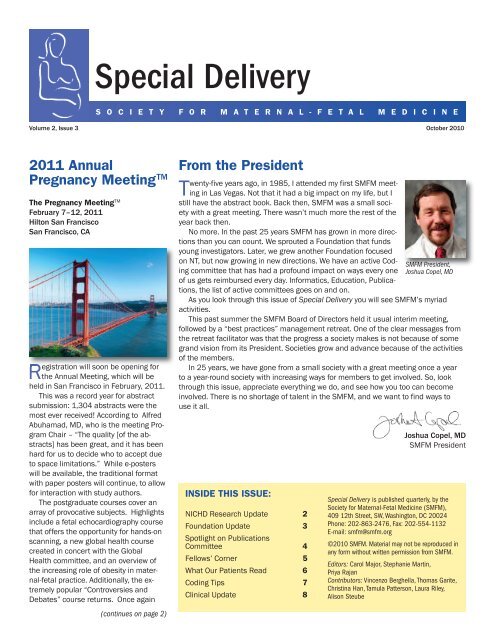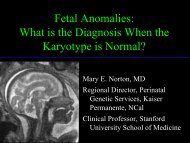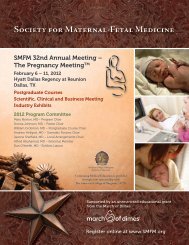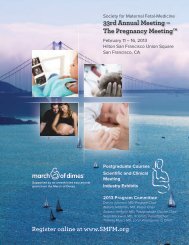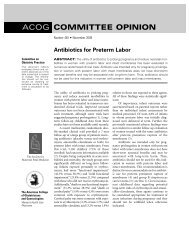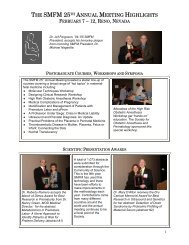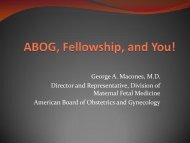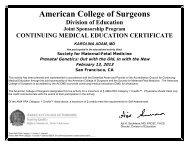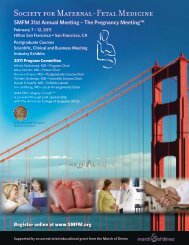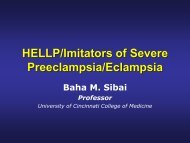Special Delivery - Society for Maternal-Fetal Medicine
Special Delivery - Society for Maternal-Fetal Medicine
Special Delivery - Society for Maternal-Fetal Medicine
You also want an ePaper? Increase the reach of your titles
YUMPU automatically turns print PDFs into web optimized ePapers that Google loves.
<strong>Special</strong> <strong>Delivery</strong><br />
S O C I E T Y F O R M A T E R N A L - F E T A L M E D I C I N E<br />
Volume 2, Issue 3 October 2010<br />
2011 Annual<br />
Pregnancy Meeting TM<br />
The Pregnancy Meeting TM<br />
February 7–12, 2011<br />
Hilton San Francisco<br />
San Francisco, CA<br />
Registration will soon be opening <strong>for</strong><br />
the Annual Meeting, which will be<br />
held in San Francisco in February, 2011.<br />
This was a record year <strong>for</strong> abstract<br />
submission: 1,304 abstracts were the<br />
most ever received! According to Alfred<br />
Abuhamad, MD, who is the meeting Program<br />
Chair – “The quality [of the abstracts]<br />
has been great, and it has been<br />
hard <strong>for</strong> us to decide who to accept due<br />
to space limitations.” While e-posters<br />
will be available, the traditional <strong>for</strong>mat<br />
with paper posters will continue, to allow<br />
<strong>for</strong> interaction with study authors.<br />
The postgraduate courses cover an<br />
array of provocative subjects. Highlights<br />
include a fetal echocardiography course<br />
that offers the opportunity <strong>for</strong> hands-on<br />
scanning, a new global health course<br />
created in concert with the Global<br />
Health committee, and an overview of<br />
the increasing role of obesity in maternal-fetal<br />
practice. Additionally, the extremely<br />
popular “Controversies and<br />
Debates” course returns. Once again<br />
(continues on page 2)<br />
From the President<br />
Twenty-five years ago, in 1985, I attended my first SMFM meeting<br />
in Las Vegas. Not that it had a big impact on my life, but I<br />
still have the abstract book. Back then, SMFM was a small society<br />
with a great meeting. There wasn’t much more the rest of the<br />
year back then.<br />
No more. In the past 25 years SMFM has grown in more directions<br />
than you can count. We sprouted a Foundation that funds<br />
young investigators. Later, we grew another Foundation focused<br />
on NT, but now growing in new directions. We have an active Coding<br />
committee that has had a profound impact on ways every one Joshua Copel, MD<br />
SMFM President,<br />
of us gets reimbursed every day. In<strong>for</strong>matics, Education, Publications,<br />
the list of active committees goes on and on.<br />
As you look through this issue of <strong>Special</strong> <strong>Delivery</strong> you will see SMFM’s myriad<br />
activities.<br />
This past summer the SMFM Board of Directors held it usual interim meeting,<br />
followed by a “best practices” management retreat. One of the clear messages from<br />
the retreat facilitator was that the progress a society makes is not because of some<br />
grand vision from its President. Societies grow and advance because of the activities<br />
of the members.<br />
In 25 years, we have gone from a small society with a great meeting once a year<br />
to a year-round society with increasing ways <strong>for</strong> members to get involved. So, look<br />
through this issue, appreciate everything we do, and see how you too can become<br />
involved. There is no shortage of talent in the SMFM, and we want to find ways to<br />
use it all.<br />
INSIDE THIS ISSUE:<br />
NICHD Research Update 2<br />
Foundation Update 3<br />
Spotlight on Publications<br />
Committee 4<br />
Fellows’ Corner 5<br />
What Our Patients Read 6<br />
Coding Tips 7<br />
Clinical Update 8<br />
Joshua Copel, MD<br />
SMFM President<br />
<strong>Special</strong> <strong>Delivery</strong> is published quarterly, by the<br />
<strong>Society</strong> <strong>for</strong> <strong>Maternal</strong>-<strong>Fetal</strong> <strong>Medicine</strong> (SMFM),<br />
409 12th Street, SW, Washington, DC 20024<br />
Phone: 202-863-2476, Fax: 202-554-1132<br />
E-mail: smfm@smfm.org<br />
©2010 SMFM. Material may not be reproduced in<br />
any <strong>for</strong>m without written permission from SMFM.<br />
Editors: Carol Major, Stephanie Martin,<br />
Priya Rajan<br />
Contributors: Vincenzo Berghella, Thomas Garite,<br />
Christina Han, Tamula Patterson, Laura Riley,<br />
Alison Steube
NICHD Research Update<br />
Guttmacher Appointed NICHD<br />
Director<br />
After an extensive national<br />
search, Allan Guttmacher,<br />
MD was named Director of the<br />
Eunice Kennedy Shriver National<br />
Institute of Child Health and<br />
Human Development (NICHD),<br />
effective August 1, 2010.<br />
A graduate of Harvard University,<br />
Dr. Guttmacher initially<br />
worked as a middle school<br />
teacher. An interest in the causes<br />
and treatments of learning disorders<br />
led to a career in medicine.<br />
Dr. Allan Guttmacher<br />
He joined the NIH from the University of Vermont, where he<br />
directed the Department of Pediatrics' Vermont Regional Genetics<br />
Center and Pregnancy Risk In<strong>for</strong>mation Service.<br />
"The NICHD's research encompasses the life span," Dr.<br />
Guttmacher said. "Its mission includes ensuring that every<br />
person is born healthy and wanted, that all children have the<br />
chance to achieve their full potential <strong>for</strong> healthy and productive<br />
lives, that couples are able to achieve the family size they<br />
desire, that childbearing is safe <strong>for</strong> all women, and that optimal<br />
rehabilitation is available to all who need it, due to injury<br />
or disease."<br />
For the full announcement, visit:<br />
http://www.nichd.nih.gov/news/releases/ 072210-<br />
guttmacher-director-NICHD.cfm<br />
NICHD Seeks Input to Develop<br />
Vision <strong>for</strong> Coming Decade<br />
The NICHD is<br />
bringing together<br />
stakeholders<br />
from multiple<br />
disciplines to develop<br />
an agenda<br />
<strong>for</strong> the next ten<br />
years. From October<br />
2010 to March<br />
2011, the Institute<br />
will sponsor a series<br />
of workshops<br />
around the vision themes of development, plasticity, cognition,<br />
behavior, reproduction, pregnancy and pregnancy outcomes,<br />
development origins of health and disease, environment, and<br />
diagnostics and therapeutics.<br />
SMFM members Patrick Catalano, George Saade, Kjersti<br />
Aagaard-Tillery and Ira Bernstein are serving as workshop organizers.<br />
These workshops will culminate in a multidisciplinary<br />
conference in June 2011 at which participants will provide<br />
feedback on the draft vision statement.<br />
Additional in<strong>for</strong>mation is available at<br />
http://www.nichd.nih.gov/vision/index.cfm<br />
2011 Annual Pregnancy Meeting (continued from page 1)<br />
the course materials will be provided on CD ROM, with a welcome<br />
improvement: the PDF files will allow course attendees<br />
to type notes.<br />
Our Local Arrangements Chair, Jim Goldberg MD, is eager<br />
to share all that this dynamic city has to offer. Be sure to<br />
check out the SMFM Facebook page <strong>for</strong> his suggestions on<br />
accommodations, restaurants, and local attractions.<br />
The meeting will begin with an opening ceremony Wednesday<br />
evening in the exhibit space with an auction to raise<br />
money <strong>for</strong> the SMFM Foundation. This year, the Exhibitor Passort<br />
Program will debut. Attendees will receive stamps in their<br />
“passport” at the exhibits allowing them the opportunity to win<br />
prizes.<br />
Page 2<br />
<strong>Special</strong> <strong>Delivery</strong>
Foundation Update<br />
Dr. Haywood Brown begins the 2009<br />
Silent Auction<br />
Dear SMFM Member,<br />
The SMFM Foundation, SMFM, and the Gottesfeld-Hohler<br />
Foundation have partnered to fund the 1st Year MFM Fellows<br />
Retreat in Palisades, New York, October 23-25. The weekend<br />
covered such topics as career skills, work-life balance, and research.<br />
Leaders in the field of maternal-fetal medicine offered<br />
their insight and knowledge to those of you who are at the beginning<br />
of your fellowship. We hope you enjoyed the opportunity<br />
to meet and mingle with each other, as well as learn<br />
helpful tools <strong>for</strong> success from physicians who have gone be<strong>for</strong>e<br />
you. We would like to thank the faculty members who took<br />
the time to join us <strong>for</strong> the weekend, the planning committee,<br />
and the SMFM staff—all of whom have dedicated their time to<br />
making the retreat a success.<br />
A record number of SMFM members have subscribed to<br />
the Literature Alert Series. The outpouring of support and<br />
enthusiasm <strong>for</strong> the project has demonstrated the need <strong>for</strong><br />
a Literature Alert geared specifically towards maternal-fetal<br />
medicine physician needs. We hope you find the articles<br />
selected to be important, interesting, and pertinent to your<br />
practice. Our volunteers, who review over 30 medical journals<br />
each month, work hard to find the most fascinating and<br />
relevant articles <strong>for</strong> each SMFM member.<br />
As a reminder, the SMFM Foundation and AJOG have partnered<br />
to make all previous AJOG/SMFM supplemental issues<br />
available electronically to members, free of charge. You can<br />
view the issues at the newly redesigned AJOG website<br />
(www.AJOG.org) under the “<strong>Society</strong> In<strong>for</strong>mation” tab.<br />
At the 2011 Annual<br />
Meeting in San Francisco,<br />
we will once again be hosting<br />
a silent auction to benefit<br />
the research and<br />
clinical grants of the Foundation.<br />
We would be<br />
thrilled if you would consider<br />
making a donation of<br />
jewelry, wine, sporting<br />
memorabilia, or other luxury<br />
item. Together we are working towards the optimization<br />
of pregnancy outcomes through advanced education and<br />
research, and we are continually building and improving on<br />
our programs thanks to the generous support of the SMFM<br />
membership!<br />
For questions about any of the above initiatives, please<br />
contact Ariste Sallas-Brookwell at asallasbrookwell@smfm.org<br />
or (202) 863-1640.<br />
Charles Lockwood, MD, John Queenan, MD, and Joshua Copel, MD enjoy their<br />
2010 silent auction prize: a day of sailing on the Long Island Sound!<br />
Sincerely,<br />
Thomas J. Garite<br />
SMFM Foundation Chair<br />
Volume 2, Issue 3 Page 3
Spotlight on Publications Committee<br />
<strong>Society</strong> <strong>for</strong> <strong>Maternal</strong>-<strong>Fetal</strong> <strong>Medicine</strong> Publications Committee<br />
The Publications Committee is charged with developing and<br />
publishing SMFM branded evidence-based papers in a variety<br />
of publications, including Contemporary Ob/Gyn (“MFM<br />
Consult series”), the American Journal of Obstetrics and Gynecology<br />
(“SMFM Clinical Opinions”), and Obstetrics and Gynecology.<br />
The Publications Committee also collaborates with<br />
other societies and organizations (e.g. ACOG) in the development<br />
of joint statements and bulletins. The committee identifies<br />
topics, selects authors, and reviews each completed<br />
paper be<strong>for</strong>e it is submitted <strong>for</strong> publication. We have published<br />
more than 30 articles already!<br />
In November 2010, the first<br />
of the new series, “SMFM Clinical<br />
Opinions”, will appear in The<br />
American Journal of Obstetrics<br />
and Gynecology. This series will<br />
provide current evidence-based guidelines <strong>for</strong> MFMs regarding<br />
issues relevant to <strong>Maternal</strong>-<strong>Fetal</strong> <strong>Medicine</strong> specialists. The<br />
topic is “Placenta Accreta”, created in collaboration with Dr.<br />
Michael Bel<strong>for</strong>t. Upcoming topics <strong>for</strong> this series are: Severe<br />
Preeclampsia Be<strong>for</strong>e 34 Weeks, <strong>Fetal</strong> Doppler, and Twin-Twin<br />
Transfusion Syndrome.<br />
In April 2009 Contemporary Ob/GYN began publishing the<br />
MFM Consult Series, and will<br />
continue the series every 2<br />
months. In these articles,<br />
SMFM members are invited to<br />
respond to clinically relevant questions regarding general and<br />
high-risk obstetrics.<br />
Other SMFM branded publications include: the State of<br />
High-Risk Pregnancy Monograph (developed with the assistance<br />
of nearly 80 <strong>Society</strong> members); Obstetrics and Gynecology<br />
papers regarding:<br />
■ Periodontal disease and adverse pregnancy outcomes—<br />
Kim Boggess<br />
■ Pregnancy in transplant recipients—Joan Mastrobattista,<br />
Veronica Gomez Lobo<br />
■ Nutrition <strong>for</strong> multiple gestations—Roger Newman, William<br />
Goodnight<br />
■ Adverse pregnancy outcomes in euploid fetues with abnormal<br />
serum markers—Lorraine Dugoff<br />
■ Magnesium sulfate <strong>for</strong> preterm birth—Brian Mercer, Amy<br />
Merlino<br />
■ Progesterone <strong>for</strong> preterm birth prevention<br />
■ Antibiotics <strong>for</strong> preterm labor, magnesium sulfate <strong>for</strong><br />
neuroprotection<br />
Other publications topics include:<br />
■ Guidelines <strong>for</strong> fetal echocardiography (with ACOG, AIUM,<br />
ACR)<br />
■ Uterine artery Doppler in pregnancy—Anthony Sciscione<br />
The Publications<br />
Committee continues<br />
to seek out<br />
members interested<br />
in participating<br />
in the<br />
publications<br />
process, including<br />
manuscript preparation<br />
and review.<br />
For a list of<br />
SMFM Publications,<br />
and to access the articles, go to www.smfm.org and click on<br />
the Publications link under the Education and Research tab at<br />
the top of the page. Or use the Publications "Quick Link" on<br />
the left hand side of the page.<br />
SMFM Consult Series Topics<br />
in Contemporary Ob/Gyn Author Publication date<br />
1. Euploid fetus with increased NT Simpson April 2009<br />
2. Progesterone <strong>for</strong> PTB Kilpatrick June 2009<br />
3. fFN and PTB Berghella August 2009<br />
4. EFM guidelines Macones October 2009<br />
5. Short Cervix Grobman December 2009<br />
6. 3rd trimester IUFD Silver February 2010<br />
7. Oral hypoglycemics in pregnancy Major April 2010<br />
8. Cerclage Berghella June 2010<br />
9. VBAC induction Macones August 2010<br />
10. Single umbilical artery Wilkins October 2010<br />
Upcoming topics:<br />
11. Low-lying placenta and previa Oyelese December 2010<br />
12. Early severe IUGR Baschat February 2011<br />
13. Cholestasis Craigo April 2011<br />
14. VTE prophylaxis <strong>for</strong> cesarean delivery Varner June 2011<br />
Page 4<br />
<strong>Special</strong> <strong>Delivery</strong>
Fellows’ Corner<br />
Welcome to the second edition of the Fellows’ Corner. We<br />
will continue to highlight relevant news and resources pertinent<br />
to SMFM Fellows and Associate Members.<br />
News & Updates:<br />
■ The 2010 First Year Fellows Retreat took place<br />
October 23-25, 2010 at the IBM Retreat Center in<br />
Palisades, NY.<br />
■ The First Year Fellows Retreat was supported by the SMFM,<br />
the SMFM Foundation and Gottesfeld-Hohler Memorial<br />
Foundation.<br />
■ The 2011 Written MFM Exam Application <strong>for</strong> the June 24,<br />
2011 exam is available online at www.abog.org. The application<br />
and fee are due November 14, 2010.<br />
■ Members can continue to connect with SMFM via Facebook at:<br />
http://www.facebook.com/pages/<strong>Society</strong>-<strong>for</strong>-<strong>Maternal</strong>-<strong>Fetal</strong>-<br />
<strong>Medicine</strong>/132460289388 and via Twitter at<br />
https://twitter.com/MySMFM.<br />
■ Be sure to visit the SMFM Fellows-In-Training Resource List.<br />
Members are available in the areas of Obstetrics, <strong>Maternal</strong>,<br />
<strong>Fetal</strong>/Prenatal Diagnosis, Research, Epidemiology, and many<br />
other fields.<br />
Dolce IBM Palisades Resort and Convention Center<br />
We look <strong>for</strong>ward to hearing your suggestions, inquiries,<br />
and comments regarding this exciting quarterly column.<br />
Tamula M. Patterson, MD, MPH<br />
drpatterson03@yahoo.com<br />
SMFM Associate Member Representative<br />
SMFM Communications Committee<br />
Christina S. Han, MD<br />
Christina.Han@yale.edu<br />
SMFM Communications Committee<br />
SMFM Foundation Awards:<br />
The SMFM/AAOGF Scholarship Award supports a single scholarship<br />
in MFM each year. These scholarships are <strong>for</strong> $100,000<br />
per year.<br />
Resources available to Fellows:<br />
■ LECTURE SERIES: The monthly SMFM Fellow and Genetics<br />
Lecture Series have been approved as didactics in the fellowship<br />
curricula, but not in lieu of regularly scheduled weekly<br />
lectures at each institution. The SMFM Fellow Lectures occur<br />
on the 1 st Wednesday of each month at 12 noon EST. The Genetics<br />
Lectures are on the 3 rd Wednesday of each month at<br />
12 noon EST. In<strong>for</strong>mation regarding upcoming and archived<br />
lectures can be found on the Fellow Lecture Series page.<br />
■ CAREER OPPORTUNITIES: For upcoming graduates, the SMFM<br />
Career Center lists available positions in MFM, organized by<br />
state and date of posting.<br />
■ WEBSITE LINKS: Many useful links can be found under the<br />
“Education and Research” tab on the SMFM website<br />
(https://www.smfm.org). Categories include <strong>Society</strong> publications,<br />
research funding opportunities, SMFM awards, and<br />
clinical trials and registries.<br />
We are happy to announce that future <strong>Special</strong> <strong>Delivery</strong><br />
issues will be showcase the series “Transitions: From<br />
Fellowship to Career”. The series will address:<br />
■ Finding the Right Career Opportunity<br />
■ Interviewing <strong>for</strong> a Job<br />
■ Contract Negotiations<br />
■ Words of Wisdom from Leaders in the Field of MFM<br />
■ and much more!<br />
Not just a revolution,<br />
a revelation<br />
The future of ultrasound is here:<br />
the new iU22 xMATRIX<br />
There are revolutions in medicine, in<br />
technology, in music, in society. Then there<br />
are revelations: ideas and insights so far<br />
advanced from what was, they alter your<br />
perception of what could be. The Philips<br />
iU22 xMATRIX is a revolutionary imaging<br />
system that will <strong>for</strong>ever change the way<br />
you view ultrasound as a clinical tool <strong>for</strong><br />
women’s imaging. Now you can see more<br />
clearly, explore more fully, and resolve<br />
more thoroughly. Now you can be sure.<br />
Take a closer look<br />
Click here to experience<br />
the future of ultrasound <strong>for</strong><br />
women’s healthcare.<br />
Volume 2, Issue 3 Page 5
What Our Patients Read<br />
This section of <strong>Special</strong> <strong>Delivery</strong> highlights<br />
articles in the popular press that<br />
pertain to topics relevant to maternalfetal<br />
medicine physicians and their patients.<br />
When available, we have<br />
included the studies these articles<br />
reference.<br />
“Weight Problems May Begin in the<br />
Womb.” www.nytimes.com<br />
9/7/2010 Jane Brody<br />
“Increasing evidence indicates that<br />
the trouble often starts in the womb,<br />
when women gain more weight than is<br />
needed to produce a healthy, full-size<br />
baby. Excessive weight gain in pregnancy,<br />
recent findings show, can result<br />
in bigger-than-average babies who are<br />
prenatally programmed to become overweight<br />
children -- who, in turn, are more<br />
likely to develop diabetes, heart disease<br />
and cancer later in life.”<br />
One of a series of articles on obesity,<br />
draws attention to two studies examining<br />
the relationship between increasing<br />
maternal weight and weight gain and<br />
subsequent birth weight and health<br />
problems in offspring.<br />
Ref: Ludwig D, Currie J. The association between<br />
pregnancy weight gain and birthweight: a withinfamily<br />
comparison. Lancet. 2010 Aug 4.<br />
Fraser A et al. Association of maternal weight gain<br />
in pregnancy with offspring obesity and metabolic<br />
and vascular traits in childhood. Circulation. 2010<br />
Jun 15.<br />
“Majority of Caesareans are done<br />
be<strong>for</strong>e labor.” www.nytimes.com<br />
8/30/2010 Denise Grady<br />
“A new study suggests several reasons<br />
<strong>for</strong> the nation’s rising Caesarean<br />
section rate, including the increased use<br />
of drugs to induce labor, the tendency to<br />
give up on labor too soon and deliver babies<br />
surgically instead of waiting <strong>for</strong> nature<br />
to take its course, and the failure to<br />
allow women with previous Caesareans<br />
to try to give birth vaginally.”<br />
References a recent study examining<br />
factors associated with cesarean delivery<br />
that found over one-half of cesarean<br />
deliveries occurred prior to the onset of<br />
labor and one-third of nulliparas were<br />
being delivered via cesarean.<br />
Ref: Zhang J et al. Contemporary cesarean delivery<br />
practice in the United States. AJOG. 2010 Aug 11.<br />
Page 6<br />
“Don't Feel Guilty About the<br />
Epidural—Researchers Say It Can<br />
Protect Your Health.”<br />
www.glamour.com<br />
Vitamin G blog 9/1/10 Sara Jio<br />
“The researchers found that epidurals<br />
might protect certain muscles from<br />
childbirth-related trauma, cutting the<br />
risk of incontinence later in life.”<br />
Highlights one of the conclusions of<br />
a study done to evaluate predictors of<br />
ultrasound-diagnosed levator trauma,<br />
which was that epidural use was associated<br />
with lower rates of levator microtrauma.<br />
Ref: Shek K, Dietz HP. Intrapartum risk factors <strong>for</strong><br />
levator trauma. BJOG. 2010 Aug 25.<br />
“One More Way to Avoid Diabetes:<br />
Breastfeed” www.time.com<br />
8/27/10 Alice Park<br />
“New moms know that breastfeeding<br />
can be good <strong>for</strong> babies, providing them<br />
with much-needed nutrition as well as a<br />
shot of antibodies and other cells that<br />
help build immune systems. Now, evidence<br />
suggests that the practice may<br />
keep the mothers themselves healthier<br />
too.”<br />
Discusses recent studies that have<br />
demonstrated protective benefits of<br />
breastfeeding with respect to metabolic<br />
disorders and how they may improve<br />
the relatively low rates of breastfeeding<br />
in the US.<br />
Ref: Schwarz EB et al. Am J Med. Lactation and<br />
maternal risk of type 2 diabetes: a populationbased<br />
study. 2010 Sep;123(9):863.e1-6.<br />
“Do Belly Blankets Protect Baby from<br />
Radiation?” www.time.com<br />
9/3/10 Catherine Sharick<br />
“... I've been testing out new products<br />
called Belly Armor, which promise to protect<br />
my baby from 99% of nonionizing radiation<br />
from mobile products, such as<br />
my iPhone and iPad…The products seem<br />
to work but they're a bit uncom<strong>for</strong>table<br />
to wear, especially in extreme hot<br />
weather, so you have to wonder, Are they<br />
necessary?”<br />
Considers devices that claim to offer<br />
fetal protection against radiation from<br />
electronic gadgets.<br />
“American Women: Birthing Babies at<br />
Home” www.time.com<br />
9/4/10 Catherine Elton<br />
“Each year, some 25,000 American<br />
women…opt to deliver their babies at<br />
home…Why? Largely because women<br />
wish to avoid what they deem overmedicalized<br />
childbirth. Compared with hospital<br />
deliveries, 32% of which end in<br />
cesarean section, those taking place at<br />
home involve far fewer medical interventions<br />
and complications.”<br />
Investigates the apparently increasing<br />
trend in home births, as well as<br />
arguments in favor of and against the<br />
practice, in the context of a recent<br />
meta-analysis that demonstrated an<br />
increase in neonatal mortality with<br />
home births.<br />
Ref: Wax J et al. <strong>Maternal</strong> and newborn outcomes<br />
in planned home birth vs planned hospital births:<br />
a metaanalysis. Am J Obstet Gynecol. Epub 2010<br />
Jul 2.<br />
<strong>Special</strong> <strong>Delivery</strong>
Coding Tips<br />
New Codes <strong>for</strong> Multiple Gestation<br />
Placenta Status ICD-9-CM Codes<br />
Codes <strong>for</strong> multiple gestations<br />
have not given enough detail<br />
about types of placenta, and<br />
placentation can affect management.<br />
The <strong>Society</strong> <strong>for</strong> <strong>Maternal</strong>-<strong>Fetal</strong><br />
<strong>Medicine</strong> (SMFM), with<br />
the endorsement by the American<br />
College of Obstetricians<br />
and Gynecologists (ACOG), presented<br />
a proposal to change<br />
this in September 2009. The resulting<br />
codes became available<br />
October 1, 2010.<br />
These codes are in a new<br />
area, unlike the prior codes in 651 Multiple gestations.<br />
How to use the new codes correctly:<br />
The primary code reflects the type of gestation (i.e., twins,<br />
triplets) (651 series) and sequence with the new subcategories<br />
(i.e., V91.x series). USE BOTH CODES.<br />
The new ICD-9-CM subcategories and codes are below:<br />
V91.0 Twin gestation placenta status<br />
V91.00 Twin gestation, unspecified number of placenta, unspecified<br />
number of amniotic sacs<br />
V91.01 Twin gestation, monochorionic/monoamniotic<br />
(one placenta, one amniotic sac)<br />
V91.02 Twin gestation, monochorionic/diamniotic (one placenta, two<br />
amniotic sacs)<br />
V91.03 Twin gestation, dichorionic/diamniotic (two placentae, two<br />
amniotic sacs)<br />
V91.09 Twin gestation, unable to determine number of placenta and<br />
number of amniotic sacs<br />
Example: Antepartum visit <strong>for</strong>, monochorionic/monoamniotic twins is<br />
reported with 651.03 & V91.01<br />
V91.1 Triplet gestation placenta status<br />
V91.10 Triplet gestation, unspecified number of placenta and<br />
unspecified number of amniotic sacs<br />
V91.11 Triplet gestation, with two or more monochorionic fetuses<br />
V91.12 Triplet gestation, with two or more monoamniotic fetuses<br />
V91.19 Triplet gestation, unable to determine number of placenta<br />
and number of amniotic sacs<br />
V91.2 Quadruplet gestation placenta status<br />
V91.20 Quadruplet gestation, unspecified number of placenta<br />
and unspecified number of amniotic sacs<br />
V91.21 Quadruplet gestation, with two or more monochorionic<br />
fetuses<br />
V91.22 Quadruplet gestation, with two or more monoamniotic<br />
fetuses<br />
V91.29 Quadruplet gestation, unable to determine number of<br />
placenta and unspecified number of amniotic sacs<br />
V91.9 Other specified multiple gestation placenta status; placenta<br />
status <strong>for</strong> multiple gestations greater than quadruplets<br />
V91.90 Other specified multiple gestation, unspecified number of<br />
placenta and unspecified number of amniotic sacs<br />
V91.92 Other specified multiple gestation, with two or more<br />
monoamniotic fetuses<br />
V91.99 Other specified multiple gestation, unable to determine<br />
number of placenta and unspecified number of amniotic sacs<br />
Note: Codes effective effective on Oct. 1, 2010.<br />
Other Diagnosis Codes to remember <strong>for</strong><br />
Multiple Gestations<br />
On Oct. 1, 2008 two codes were released <strong>for</strong> specific twin<br />
conditions:<br />
■ <strong>Fetal</strong> conjoined twins are reported as code 678.1x.<br />
■ When TTTS has been diagnosed, report two codes: 651.0x<br />
Twin pregnancy (be sure to report twin gestation as primary)<br />
with 678.0x <strong>Fetal</strong> hematologic conditions.<br />
Twin-to-twin transfusion syndrome should not be confused<br />
with the condition twin oligohydramnios-polyhydramnios syndrome<br />
(TOPS). For this you would report three codes: 651.0x,<br />
658.0x Oligohydramnios, and 657.0x<br />
Polyhydramnios.<br />
Code Fetus(es) Loss in Multiple<br />
Gestation<br />
■ For a diagnosed twin pregnancy with a loss of one fetus and<br />
retention of one fetus, report 651.3x Twin pregnancy with<br />
fetal loss and retention of one fetus.<br />
■ For a diagnosed triplet pregnancy with a fetal loss and retention<br />
of one or more fetus(es), report 651.4x Triplet pregnancy<br />
with fetal loss and retention of one or more<br />
fetus(es).<br />
■ For a diagnosed quadruplet pregnancy with a fetal loss and<br />
retention of one or more fetus(es), report 651.5x Quadruplet<br />
pregnancy with fetal loss and retention of one or more<br />
fetus(es).<br />
■ If the pregnancy is greater than quadruplets, with a fetal<br />
loss and retention of one or more fetus(es), report 651.6x<br />
Other multiple pregnancy with fetal loss and<br />
retention of one or more fetus(es).<br />
Important: Sometimes in a multiple gestation, the patient<br />
may decide to have an elective fetal reduction per<strong>for</strong>med. If<br />
this occurs, the procedure code is reported as CPT® 59866<br />
Multifetal pregnancy reduction(s) (MPR) and the correct<br />
diagnosis code to report would be 651.7x Multiple<br />
gestation following (elective) fetal reduction.<br />
Note: x= additional fifth digit is required to define the episode<br />
of care<br />
Volume 2, Issue 3 Page 7
Clinical Update<br />
Are you cocooning your newborns?<br />
There has been a dramatic increase in adult and adolescent pertussis cases in<br />
the past decade 1 . There has also been an increase in the number of deaths<br />
among 0-4 month old and > 4 month old infants due to pertussis in this same time<br />
frame. In a study of 95 laboratory-confirmed cases of infant pertussis, 76-83% of<br />
transmission originated <strong>for</strong>m household members (parents, siblings, other relatives<br />
and caretakers) 2 ACIP has recommended <strong>for</strong> several years “cocooning”, which<br />
means immunization of family members and close contacts of newborn infants who<br />
can not be vaccinated until after 6 months of age. Immunity to pertussis wanes<br />
after childhood immunization. There<strong>for</strong>e, susceptible adults are reservoirs of<br />
B.pertussis. These new parents should receive a Tdap booster postpartum prior to<br />
discharge from the hospital. Standing orders <strong>for</strong> this vaccination may increase your<br />
success in promoting cocooning <strong>for</strong> newborns. FInally, all healthcare providers<br />
should also receive the Tdap booster to protect infants while they are hospitalized.<br />
1. www.cdc.gov<br />
2. Wendelboe AM, et al. Pediatr Infect Dis J. 2007;26:293-299.<br />
www.alere.com<br />
Mother’s peace<br />
of mind...<br />
Baby’s future...<br />
Amniotic Fluid can provide<br />
more than just in<strong>for</strong>mation<br />
<strong>for</strong> you and your patient!<br />
Cutting edge service<br />
from Biocell Center!<br />
For patients with complicated pregnancies,<br />
Alere is always on call.<br />
Alere: Has helped manage 1.1 million pregnancies to date<br />
• Offers patient assistance 24/7 • Assists with insurance<br />
authorization, <strong>for</strong> easy approval • Now offers prenatal<br />
genetic testing and counseling. Questions: 1.800.950.3963<br />
CLICK HERE E or<br />
to learn more.<br />
call<br />
866-BIO-2620<br />
www.biocellcenter.com<br />
. com<br />
Functional nal Heart Valve<br />
Grown From Amniotic Fluid *<br />
© 2010 Inverness Medical. All rights reserved. Alere and The 24/7 Obstetric<br />
Nursing Company are trademarks of the Inverness Medical group of companies.<br />
*Schmidt D., et<br />
al,<br />
J<br />
Heart<br />
Valve Dis. 2008. 17(4):446-55 Prenatally Fabricated Autologous<br />
Human<br />
Living<br />
Heart<br />
Valves<br />
Based<br />
onAmniotic<br />
Fluid<br />
Derived Progenitor Cells<br />
as<br />
Single<br />
Cell Source. Although<br />
theree<br />
is<br />
no guarantee antee<br />
that<br />
the<br />
FDA<br />
will approve any<br />
potential future medical<br />
applications<br />
and<br />
banking<br />
of<br />
amniotic<br />
fluid does<br />
not<br />
guarantee antee that<br />
these<br />
cells<br />
will be<br />
applicable<br />
to<br />
a<br />
particular medical<br />
condition,<br />
many<br />
clinical<br />
trials<br />
are<br />
on-going worldwide that may result in human therapies. Preserving amniotic fluid stem cells offers fe<br />
great hope <strong>for</strong> the future.<br />
Page 8<br />
<strong>Special</strong> <strong>Delivery</strong>


